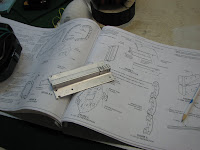I was just about to finish the bulkhead by riveting the 8 nut plates into place when I was realizing despite my thorough inventory I did when the kit arrived I must have overlooked a missing K1000-3 nut plate. I couldn't believe it and so I was counting about 5 times .... 8 places for nut plates and, yes, the plans indicate all are K1000-3 - a look in my sorter showed 7 nut plates for the K1000-3 and none in adjacent drawers, so nothing got mixed up. I finally accepted it and realized that it wasn't that bad as it wouldn't hold me back. Until I finally install the Stabilator on the tail cone I can still reach the place to rivet the missing nut plate in place. Order to Van's along with 3 tie down eyebolts went out right away and I saw that they already shipped it, so it should arrive some time next week.
Well, I riveted in place what I could to almost finish the bulkhead.

Then I went on to install the side plates and the bearings for the Stabilator. After the squeeze training I had yesterday, doing 12 more was a piece of cake :-)

This job went pretty fast and so I decided to look ahead again and see what else I could do to add to the upcoming priming spree. There were a few parts that just needed deburring - next to the attach point of the vertical stabilizer which needed some final drilling and dimpling.

It really didn't take long and with the help of the big and small Scotchbrite wheels it was soon turned into this:

Finally I went outside of the nice cool A/C of my shop to work on prepping some more skins to get them ready for priming, along with the small parts that I had just deburred. With the monsoons sweeping in the afternoons the humidity is too high for spraying so I hope I can do that tomorrow morning and have the day time for drying it.
I got 4 more skins done, only 3 more to go but this will have to wait for the next batch. Spraying those skins really takes time.











































